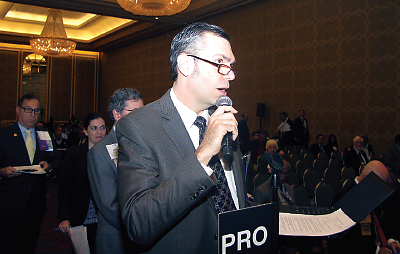Solitary confinement of juveniles in correctional settings is detrimental to adolescent health and should be prohibited, except for extraordinary circumstances such as those that involve protection of the juvenile, staff, or other detainees.
That’s what physicians at the AMA House of Delegates resolved at this year’s Interim Meeting in November.
They further agreed to put the AMA on record as opposing the use of solitary confinement of juveniles for disciplinary purposes in correctional facilities and emphasized that isolation of juveniles for clinical or therapeutic purposes must be conducted under the recommendation and supervision of a physician.
Debate on the issue was triggered by a resolution from the Medical Student Section that called on the AMA to oppose solitary confinement under all circumstances, for adults as well as juveniles, and also for patients with mental illness. During testimony in reference committee hearings, where reports and resolutions are debated before being sent to the full House of Delegates, Benjamin Mazer, a medical student and one of the paper’s authors, said that solitary confinement is now “widespread in U.S. prisons, including hundreds of thousands of documented uses in mentally ill individuals and juveniles.”
He added, “While solitary confinement is sometimes used for safety reasons, it is more often employed merely as a disciplinary tool. Unfortunately, this tool has many medical harms associated with it.”
Carolyn Robinowitz, M.D., chair of the Section Council on Psychiatry, reminded delegates that for millions with severe mental illness, the nation’s jails and prisons have become a substitute for hospitalization. She read excerpts from official APA policy on segregation in corrections facilities, which states, “Prolonged segregation of adult inmates with serious mental illness with rare exceptions should be avoided due to the potential harm to such inmates.”
But some emergency and other physicians testified that seclusion of adults is necessary and unavoidable in certain emergency hospital settings, and physicians working in correctional facilities argued the same for adults in jails and prisons.
Brooks Bock, M.D., representing the AMA Section Council on Emergency Medicine, told delegates, “In the emergency department we do use solitary confinement, we do see incarcerated patients, and we do need to be able at times to place patients in a unique environment where they are observed behind closed doors to protect them and the staff that are caring for them.”
Robinowitz and other psychiatrists acknowledged that sound policy regarding confinement of adults in correctional and other settings is far more complex than policy regarding confinement of juveniles and argued for focusing the current resolution exclusively on juveniles—a revision ultimately approved by the full House of Delegates.
Speaking on behalf of the Section Council on Psychiatry, Barry Wall, M.D., delegate from the American Academy of Psychiatry and the Law, offered to work with the Medical Student Section on a separate resolution about adults at next year’s House of Delegates meeting. “If the resolution were to focus on juvenile-detention facilities only, we would certainly oppose the use of solitary confinement because of the developmental vulnerability of juveniles,” he said. “But [the issue] of placing adult offenders with mental illness in solitary confinement poses a lot more challenges.”
Regarding the recommendation against solitary confinement of juveniles, except in very rare cases, there was widespread agreement. “The potential psychiatric consequences of prolonged seclusion include depression, anxiety, and psychosis,” said David Fassler, M.D., alternate delegate from the American Academy of Child and Adolescent Psychiatry. “Juveniles are at particularly high risk for such consequences. We also know that the majority of suicides in juvenile correctional facilities occur when the person is isolated or in solitary confinement.” ■
The resolution and other items of business at the AMA House of Delegates can be accessed
here.

